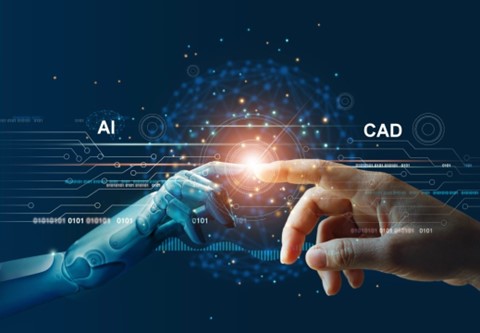The computer graphics (CG) industry originated with the development of the first computer-aided design (CAD) programs in the early 1960s. CG objects are based on a Euclidean drawing system, evolving from CAD programs to modern modeling programs. CAD’s integration with artificial intelligence (AI) in the design process accelerates world creation. The AI impact may reduce human roles but presents new modeling opportunities. CAD’s importance in checking, tweaking, and rendering solid models for accurate visualization remains crucial. While considered mundane, CAD forms the foundation for CG, ensuring photorealistic accuracy in images through its 70-year-old technology.

The computer graphics industry was started with the development of the first computer-aided design programs in the early 1960s. 3D wireframe and 2D layout programs are the foundation of everything CG. Most people in the industry have seen the photos of engineers, sitting in front of a large flat-faced CRT with a light pen, doing CAD.

CAD programs were used in the early days, and some brave souls built their own programs. Ed Catmull made the first polygonal 3D computer-animated CG film of a hand in 1972 with a 3D modeling and animation program he wrote. It could reproduce a disembodied hand on a screen and make it move.

In CG, the objects used to create scenes and people are based on a Euclidean drawing system of which a CAD program could be the basis. However, in the CG realm, such 3D systems have become known as modeling programs. The 3D objects are the foundation for the CG model.
The computer-aided design industry has undergone significant transformations since its emergence in the late 1950s and early 1960s. The advent of CAD in the 1960s ushered in an era of automation up to the ’80s that persists today. However, CAD is now just one element within a progressively intricate system tied to the real and virtual worlds.
Design, modeling, and engineering (encompassing manufacturing, AEC, infrastructure, civil engineering, media and entertainment, and more) are evolving to embrace technological advancements such as cloud-based workflows, IoT (Internet of Things), and artificial intelligence and machine learning. These developments contribute to the creation of digital twins for real-world products and structures. But CAD backed by AI can make worldscapes, universes, forests, castles, and dragons. Adding AI aspects to modeling has accelerated and improved the richness of the worlds being created and sped up the creation of such worlds, and the objects, vehicles, and people within them.

The integration of artificial intelligence and machine learning techniques will have a profound change in the model creation process, potentially leading to a decrease in the number of human roles involved. However, there is optimism that new opportunities will emerge, focusing on roles where individuals teach machines to perform more complex tasks. Fortunately, the pace of change is rapid, offering a swift adaptation to professionals without necessitating a job hunt. The lingering impact of the pandemic presented considerable challenges, affecting companies as they hastily transitioned to remote work, experienced factory closures, and grounded sales teams. While uncertainties persist, the evolving landscape promises swift changes and opportunities for those in the professional realm.
CAD suppliers used to have a big presence at Siggraph exhibitions, but as Siggraph shifted its emphasis to the movies, the CAD companies left Siggraph and organized their own conferences centered around their users.
After all the modeling work is done in a CAD project, whether it’s the design of a skyscraper, a car, an airplane, or an alien monster, it must be checked to see if it has any cracks—vertices that didn’t quite connect correctly. That is done in a first-pass visualization, and it’s basically a manual checking process performed by a human who rotates and tilts the model looking for imperfections in the polygon alignments—cracks of light show through if they don’t.
When the model is solid (not a reference to solid modeling but meaning rock-solid, reliable, correct), it’s ready for final visualization, which involves ray and path tracing. Sometimes, just prior to the physically accurate rendering step, engineers, designers, and marketing people will look over the design in a CAVE or with a VR headset (sometimes called a CAVE on your face). This is the stage where tweaks are made. A floor is added or removed from a building; a steering wheel is raised, lowered, or moved sideways; a space alien has a claw added or removed.
All that tweaking involves moving vertices in the CAD model. And a critical part of the process is making sure all the attributes about that vertex, its material, color, stress factors, weight, etc., follow it and properly interact with peripheral vertices and their environmental data.
It’s all modeling, say the visualization specialists and artists. It’s all CAD, say the mechanical and AEC engineers. It’s all the above, and all that matters in the results.
The thing that made a GPU so valuable was the integration of the transformation and lighting engine. The transformation engine is what manages the vertices and their metadata. It’s the front of the CG and GPU pipeline.
CAD is no longer a vouge term in the CG world. It’s considered mundane and even trivial. Modeling, the snazzy word for CAD, is much preferred. But underneath every front-end modeler is a CAD engine, either homegrown or licensed. And at the other end of a CG pipeline is the ray-tracing engine—either homegrown or licensed. But ray tracing could never be photorealisticly accurate if it didn’t have a rock-solid CAD model to base its light projections and bounces on.
So, the foundation of all the beautiful images we look at in the movies, TV, ads, and magazines owe their existence to CAD, a 70-year-old-plus technology that holds up the world. Give your grandfather a little credit.